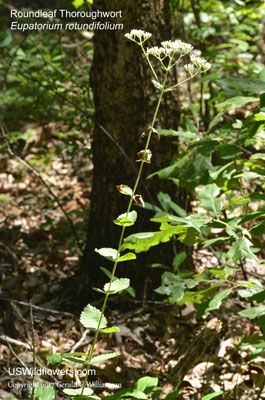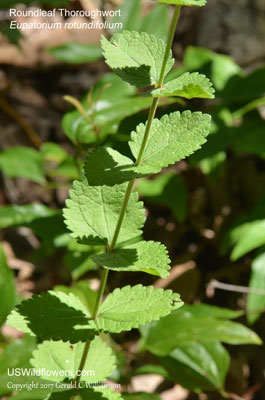Roundleaf Thoroughwort, Common Roundleaf Eupatorium - Eupatorium rotundifolium
|
Eupatorium rotundifolium - Roundleaf Thoroughwort, Common Roundleaf Eupatorium.
There are at least 24 Eupatorium species in North America; over 40 worldwide, with Thoroughworts also being found in Europe and Asia. It used to be a larger genus, with Eutrochium (Joe Pye Weed) being included in Eupatorium until fairly recently, with several other genera also being included in Eupatorium in the further past.
Eupatorium rotundifolium has wide distribution across most of the eastern half of the United States, from Texas to southern New Hampshire and Maine. It is quite variable with a propensity to hybridize, and also has been classified by some authorities as having 3 varieties. The differences are primarily in the leaves. Recent efforts at classifying this confusing genus have instead given these varieties full species status: Eupatorium rotundifolium var. rotundifolium stays as Eupatorium rotundifolium, Eupatorium rotundifolium var. ovatum is classified as Eupatorium pubescens, and Eupatorium rotundifolium var. scabridum is classified as Eupatorium scabridum. Eupatorium cordigerum has also been considered a variety in the past. Excluding var. ovatum from the species also means that Eupatorium rotundifolium is not found in the extreme northeastern states in the range shown in the map to the right, and in my "Found in" list below (MA, ME, NH.)
Found in:
AL, AR, CT, DC, DE, FL, GA, IN, KY, LA, MA, ME, MS, NC, NH, NJ, NY, OH, PA, RI, SC, TN, TX, VA, WV | 
Distribution of Eupatorium rotundifolium in the United States and Canada:

Blue=Native; Grey=Introduced
Map from USDA Plants Database:
USDA, NRCS. 2017. The PLANTS Database (http://plants.usda.gov, 09 May 2025). National Plant Data Team, Greensboro, NC 27401-4901 USA.
Search Our Database: Enter any portion of the Scientific, Common Name, or both.
Do a general Google search of the entire site:
#ad
 Follow USWildflowers on Twitter
| | Site: May Prairie State Natural Area, Coffee County, TN Date: 2017-July-10 | Photographer: Gerald C. Williamson
Nikon D7000
Tamron SP 90MM f/2.8 AF Macro | | The flower heads of all Eupatorium consist only of white disc florets; 5 in each head. The heads of Eupatorium rotundifolium are in corymbiform arrays where the hairy branches are opposite. | | 
| | Site: May Prairie State Natural Area, Coffee County, TN Date: 2017-July-10 | Photographer: Gerald C Williamson
Nikon D7000 | | Roundleaf Thoroughwort grows up to about 5 feet tall; this one is around 3 feet. A single stem arises from a short rhizome; it may have a few branches in the upper portion of the plant. | | Click on the photo for a larger image

| | Site: May Prairie State Natural Area, Coffee County, TN Date: 2017-July-10 | Photographer: Gerald C Williamson
Nikon D7000 | The leaves are the key to differentiating between the varieties of Eupatorium rotundifolium - or the similar species if you subscribe to elevating the varieties to species level. Here is the key from Weakley's Flora:
- Leaf base broadly rounded, cordate-clasping; leaves very densely pubescent, the pubescence often harsh; larger leaves usually 4-10 cm long; principal pair of lateral veins diverging from the midrib 2-10 mm above the base of the leaf; toothing of leaf often irregular and coarse....... E. cordigerum (E. rotundifolium var. cordigerum)
- Leaf base cuneate, broadly cuneate, rounded, or cordate (but not clasping); leaves densely to sparsely pubescent; larger leaves usually 2-6 cm long; principal pair of lateral veins diverging at the base or 2-10 mm above the base of the leaf; toothing of leaf regular and relatively fine.
- Leaves mostly 1-1.5 (-1.7)x as long as wide, tending to be obtuse (the apex usually 90 degrees or more), the teeth generally rounded (the 2 sides of each tooth usually distinctly convex-curved, the end of the tooth therefore rounded), the principal pair of lateral veins diverging directly from the base of the midrib ...... E. rotundifolium (E. rotundifolium var. rotundifolium)
- Leaves mostly (1.2-) 1.5-2x as long as wide, tending to be acute (the apex usually 90 degrees or less), the teeth generally rather sharp (the 2 sides of each tooth straight to gently curved, the end of the tooth therefore triangular), the principal pair of lateral veins diverging 2-10 mm above the base of the midrib.
- Leaves broadly cuneate to broadly rounded, thin in texture, the pubescence rather soft and long (and also often sparse), the leaf blade not twisted at base, not borne in a vertical plane, up to 10 cm long and 6.5 cm wide ...... E. pubescens (E. rotundifolium var. ovatum)
- Leaves distinctly cuneate, firm in texture, the pubescence rather harsh and short, the leaf blade twisted at the base, thus borne in a vertical plane, up to 5.5 cm long and 3 cm wide ...... E. scabridum (E. rotundifolium var. scabridum)
| | Click on the photo for a larger image

|
References used for identification and information:
|
|
| |
| #ad
|
|





